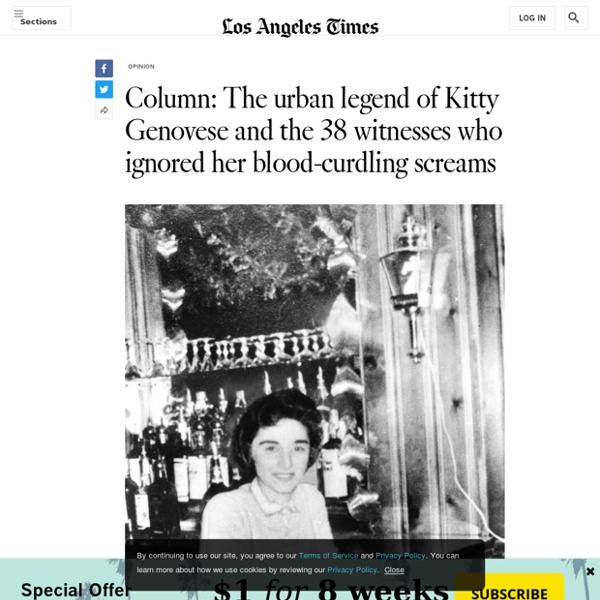An avoidable murder of a student caught on tape: the sickening power of the bystander effect
On Sept. 17, the life of a 16-year-old high schooler in Long Island ended tragically in a violent brawl outside a strip mall. Khaseen Morris was told to show up outside the mall at a certain time by several others his age, after he was seen walking home the girlfriend of another boy. Morris showed up and was immediately attacked by a group of five teenagers.
Facts & Summary of Kitty Genovese
Catherine Susan “Kitty” Genovese was born in Brooklyn, New York, on July 7, 1935, to parents Vincent and Rachel Genovese. The oldest of five children, Genovese was a graduate of Prospect Heights High School and remembered as a very good student and voted “Class Cut-Up” in her senior year. Following her graduation in 1953, Genovese’s mother witnessed a murder on the streets, which motivated the family to move to New Canaan, Connecticut. Kitty Genovese, however, remained in New York City, working as a secretary at an insurance company and working nights at Ev’s 11th Hour, a bar in the Hollis neighborhood of Queens, first as a bartender then as the manager, prompting her to move to Queens. A decade later, Genovese met her lesbian girlfriend, Mary Ann Zielonko, in a Greenwich Village nightclub.
10 Notorious Cases of the Bystander Effect
The bystander effect is the somewhat controversial name given to a social psychological phenomenon in cases where individuals do not offer help in an emergency situation when other people are present. The probability of help has in the past been thought to be inversely proportional to the number of bystanders. In other words, the greater the number of bystanders, the less likely it is that any one of them will help. This list describes the prototype of the effect and cites nine particularly heinous examples.
What Is the Bystander Effect? – Now. Powered by Northrop Grumman
If you see someone in distress, will you help them? We all like to consider ourselves to be good people, but when we’re caught in the moment, we freeze. What is the bystander effect? For more than 50 years, psychologists have observed this phenomenon again and again in experiments and in real life. The research overwhelmingly shows the more people that are present when there’s an emergency, the less likely they are to help.
Bystander effect – News, Research and Analysis – The Conversation – page 1
At least half of campus sexual assaults involve alcohol. But prevention programs at US colleges and universities don’t address what that means for bystanders. Incorporating lessons on healthy sexual behavior into sex ed classes and special prevention programs for youth could be key to reducing sexual violence, experts say. Research shows that few people take a stand when they witness sexual harassment.
4 Major Implications of Bystander Effect on the Society
The Bystander effect is a social psychological phenomenon wherein a bystander is unlikely to help someone in need when there’s presence of other people around. The bystander effect, also known as bystander apathy is inversely proportional to the total number of bystanders. The more the bystanders, lesser chances of someone helping the person in need, the lesser the bystanders, the more are the chances of someone helping the person in need. The main cause of bystander effect is diffusion or diversion of responsibility.
Reducing the Bystander Effect
As discussed, there are a number of factors that magnify the Bystander Effect. Fortunately, there are also a number of factors that weaken it. Once again, factors can be divided into characteristics of the situation, and of the people. Situational characteristics Dangers of the incident The perceived danger of intervening in a critical situation has the greatest influence in reducing the Bystander Effect.
Gang Rape Victim Is Church-Going Honor Student
Oct. 29, 2009— -- The victim of last weekend's brutal gang rape at her homecoming dance was a devout Christian who attended church three times a week and whose friends say had been looking forward to the homecoming dance for weeks. Kami Baker, one of the victim's close friends, said the girl came to the dance Saturday evening clad in a sparkling purple gown, diamond necklace and matching silver shoes. "When we walked in the dance together she said, 'I can't wait to get my dance on!'" Baker,16, told ABCNews.com. But what began as a night the teen girls were looking forward to at Richmond High School outside San Francisco, soon became a nightmare, when the 15-year-old became victim to a horrific two-and-a-half hour gang rape in a dark corner of the school grounds.
If You’re in Danger, Will Bystanders Help?
Almost every psychology student knows about Kitty Genovese, the 28-year-old Queens woman who was stabbed to death in 1964. At the time, the New York Times reported that no one had lifted a finger to rescue her. Though that story was later debunked—some people did call the police or shout down the assailant—Genovese’s death provoked a flurry of research on what’s now called the bystander effect. According to decades of experiments, the more people who are observing someone in trouble, the less likely each person is to help.



